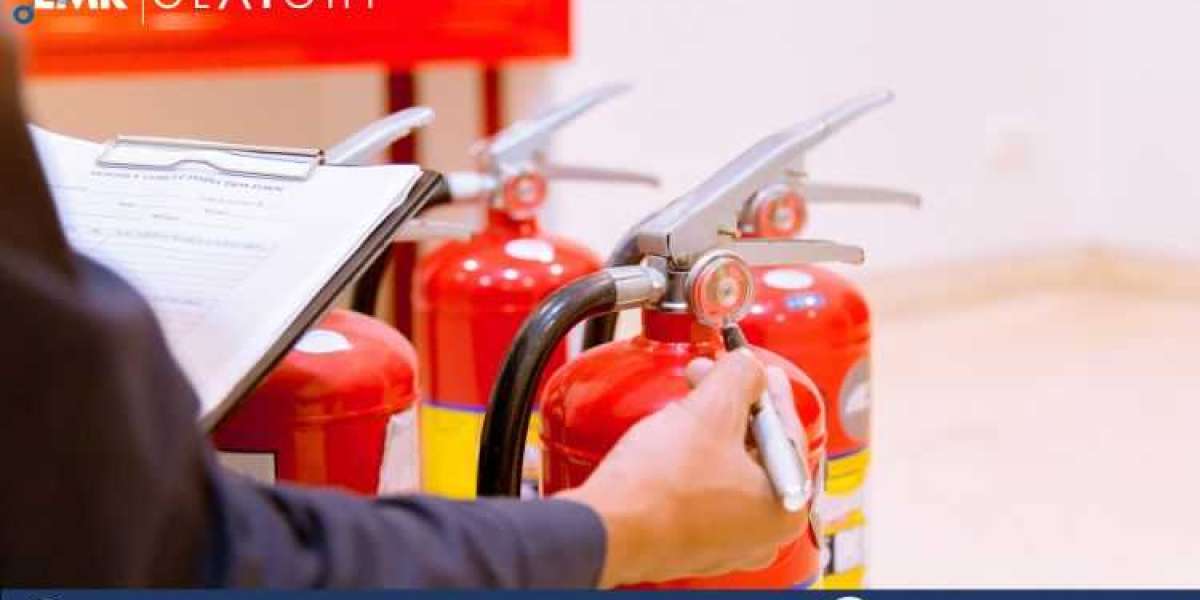Fire safety is a crucial aspect of any building, whether it is a home, a workplace, or a public facility. Fire accidents can cause serious damage to property, injuries, and even fatalities. Therefore, it is important to have adequate fire prevention and protection measures in place to minimize the risk of fire hazards and to respond effectively in case of a fire emergency.
One of the most essential firefighting equipment is a fire extinguisher. A fire extinguisher is a portable device that can be used to extinguish small fires or to contain them until the fire department arrives. The Mexico fire extinguisher market size reached approximately USD 110.87 million in 2023. The market is assessed to grow at a CAGR of 4.8% between 2024 and 2032 to attain a value of around USD 168.26 million by 2032. This indicates the growing demand and awareness of fire extinguishers in Mexico.
However, not all fire extinguishers are the same. Different types of fires require different types of fire extinguishers. In this blog post, we will explain the fire classes and fire extinguisher types, how to select and place fire extinguishers in your building, how to use and maintain them properly, and the regulatory compliance for fire safety in Mexico.
Fire Classes and Fire Extinguisher Types
Fires are classified into five categories based on the type of fuel that is burning. These are:
- Class A: Fires involving ordinary combustible materials, such as wood, paper, cloth, rubber, and plastic.
- Class B: Fires involving flammable liquids, such as gasoline, oil, paint, and solvents.
- Class C: Fires involving energized electrical equipment, such as wiring, appliances, motors, and generators.
- Class D: Fires involving combustible metals, such as magnesium, aluminum, titanium, and sodium.
- Class K: Fires involving cooking oils and fats, such as vegetable oil, animal fat, and grease.
Different types of fire extinguishers are designed to be effective for different fire classes. The most common types of fire extinguishers are:
- Water-based extinguishers: These extinguishers use water or water-based solutions to cool down and smother Class A fires. They are not suitable for Class B, C, D, or K fires, as they can spread the fire or cause electric shocks.
- Dry chemical extinguishers: These extinguishers use dry chemical agents, such as sodium bicarbonate, potassium bicarbonate, or monoammonium phosphate, to create a barrier between the fuel and the oxygen and to interrupt the chemical reaction of the fire. They are effective for Class B and C fires, and some models can also be used for Class A fires.
- CO2 extinguishers: These extinguishers use carbon dioxide gas to displace the oxygen and to suffocate the fire. They are ideal for electrical fires (Class C) and flammable liquid fires (Class B), as they do not leave any residue that can damage the equipment. However, they are not effective for Class A, D, or K fires, as they do not cool down the burning material.
- Specialized extinguishers: These extinguishers use specific agents to combat Class D and K fires. For example, Class D extinguishers use dry powder agents, such as sodium chloride, graphite, or copper, to smother and isolate the burning metal. Class K extinguishers use wet chemical agents, such as potassium acetate, potassium citrate, or potassium carbonate, to create a foam layer that prevents re-ignition and cools down the oil or fat.
Selection and Placement of Fire Extinguishers
Choosing the right type and number of fire extinguishers for your building depends on several factors, such as the size and layout of the building, the potential fire hazards present, and the occupancy and usage of the building. Some general guidelines for selecting and placing fire extinguishers are:
- Identify the fire classes that are most likely to occur in each area of the building and select the appropriate fire extinguisher type for each area.
- Ensure that the fire extinguishers are easily accessible and visible, and that they are not blocked by furniture, doors, or other obstacles.
- Place the fire extinguishers near the exits, corridors, stairways, and other escape routes, so that they can be reached quickly and safely in case of a fire.
- Install the fire extinguishers at a suitable height, usually between 3 and 5 feet from the floor, and secure them with brackets or cabinets to prevent them from falling or being tampered with.
- Follow the manufacturer's instructions and the local fire codes for the minimum number and size of fire extinguishers required for each area. As a general rule, each floor of the building should have at least one fire extinguisher for every 3,000 square feet of floor area.
Proper Use and Maintenance
Having fire extinguishers in your building is not enough. You also need to know how to use them properly and how to keep them in good working condition. Here are some tips for using and maintaining fire extinguishers:
- Before using a fire extinguisher, make sure that the fire is small and contained, that you have a clear escape route, and that you have alerted the fire department or the building's fire alarm system.
- Remember the acronym PASS to use a fire extinguisher effectively. PASS stands for Pull, Aim, Squeeze, and Sweep. Pull the pin to break the seal, Aim the nozzle at the base of the fire, Squeeze the handle to release the agent, and Sweep the nozzle from side to side until the fire is out.
- After using a fire extinguisher, do not leave it unattended. Dispose of it safely or recharge it according to the manufacturer's instructions.
- Inspect your fire extinguishers regularly, at least once a month, to check for any signs of damage, leakage, corrosion, or low pressure. If you notice any problems, replace or repair the fire extinguisher immediately.
- Have your fire extinguishers serviced by a qualified professional at least once a year, or more frequently if required by the local fire codes. The service should include a thorough examination, cleaning, testing, and recharging of the fire extinguisher.
Regulatory Compliance
Fire safety is not only a matter of common sense, but also a matter of law. In Mexico, there are various fire safety regulations and standards that govern the installation and maintenance of fire extinguishers in different types of buildings. Some of the main sources of fire safety regulations in Mexico are:
- The Official Mexican Standard NOM-002-STPS-2010, which establishes the minimum fire prevention and protection conditions in workplaces.
- The Official Mexican Standard NOM-154-SCFI-2005, which establishes the specifications and test methods for portable fire extinguishers.
- The Official Mexican Standard NOM-003-SEGOB-2011, which establishes the characteristics and specifications of the fire safety signs and signals.
- The Mexican Civil Protection Law, which regulates the actions and procedures for civil protection in case of emergencies and disasters.
- The local fire codes and ordinances, which may vary from state to state and from municipality to municipality, and which may impose additional requirements for fire safety in specific types of buildings.
It is important to comply with these fire safety regulations and standards, not only to avoid fines and penalties, but also to ensure the safety and well-being of the occupants and visitors of your building. Therefore, you should consult with the local fire authorities and fire safety experts to determine the applicable fire safety requirements for your building and to obtain the necessary permits and certifications.
Fire extinguishers are vital tools for fire safety, but they are not the only ones. You should also have a comprehensive fire safety plan that includes fire prevention measures, fire detection and alarm systems, fire suppression systems, fire evacuation procedures, and fire safety training and education. By implementing these fire safety measures, you can reduce the risk of fire accidents and protect your building and its occupants from the devastating effects of fire.






